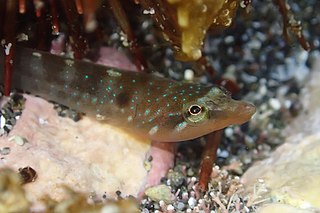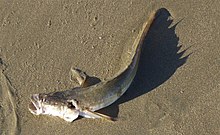Deania is a genus of long-snouted, deepwater dogfish sharks in the family Centrophoridae.

The New Zealand topknot is a triplefin of the genus Notoclinus, found around the North Island of New Zealand in reef areas of broken rock and brown seaweed.

Gobiopsis atrata, the New Zealand black goby, is a species of goby endemic to the marine waters around northern New Zealand where it occurs in tide pools and on reefs down to depths of about 30 metres (98 ft). It lives in narrow crevices and is most commonly seen with its head poking out of its lair to which it will hastily retreat if disturbed. This species can reach a length of 8.5 centimetres (3.3 in) TL.

The New Zealand urchin clingfish is a clingfish. It is found around New Zealand wherever sea urchins are present. Its length is between 2 and 3 cm.

The New Zealand black angelfish or the black scalyfin, Parma alboscapularis, is a damselfish of the family Pomacentridae, found around northeastern New Zealand to depths of a few metres, over shallow rocky reef areas. Its length is between 24 and 28 cm.

The New Zealand rockfish, Acanthoclinus littoreus, is a roundhead of the genus Acanthoclinus, found only in New Zealand from shallow depths to 15 m. Their length is between 5 and 15 cm.

Graham's gudgeon, Grahamichthys radiata, is a species of goby of the family Thalasseleotrididae, the only member of the genus Grahamichthys. This species is found in rock pools and in the neritic zone, to 50 metres (160 ft) in depth, where sand or mud is lies around and partially buries rocks, shells, or other objects. It is unusual for a goby, in that it lives in loose schools.
Bruun's cutthroat eel, Histiobranchus bruuni, is a cutthroat eel of the genus Histiobranchus, found around New Zealand at the bottom of the deep ocean basin at depths of between 4,000 and 5,000 m. Their length is between 40 and 60 cm.
The rough-head whiptail or oblique banded rattail, Coelorinchus aspercephalus, is a species of rattail found around New Zealand including islands to New Zealand's south, at depths of between 30 and 300 m. Its length is between 15 and 35 cm.
The blue grenadier is a merluccid hake of the family Merlucciidae found around southern Australia and New Zealand, as well as off both the Atlantic and Pacific coasts of South America from Peru to Brazil at depths of between 10 and 1,000 m. It feeds in midwater on small squids, crustaceans, and fish. Its length is between 60 and 120 cm. It is a slender, silvery fish similar in appearance to the gemfish. The meat of the fish is white and almost always sold in fillets; culinarily it is considered a whitefish.

The New Zealand sole or common sole, Peltorhamphus novaezeelandiae, is a righteye flounder of the genus Peltorhamphus, found around New Zealand in shallow enclosed waters less than 100 m in depth. Their length is from 25 to 45 cm.

The greenback horse mackerel or greenback scad is a species of jack in the family Carangidae, found around western and southern Australia, and around New Zealand, from the surface to depths of 460 m. Its length is up to 64 cm.

The longnose spurdog is a dogfish shark of the genus Squalus, found over continental shelves in all oceans, at depths of between 15 and 800 metres. They reach one metre in length.

The saddletail grouper, also known as black cod or black rock-cod in Australia, and as saddle-tailed grouper or spotted black grouper in New Zealand, is a large marine fish of the family Serranidae. It is found off the coastline of southeastern Australia and northern New Zealand, generally inhabiting near-shore rock and coral reefs at depths down to 50 metres. Its main range comprises the southeast coastline of Australia, in the state of New South Wales; New Zealand populations are suspected to be nonbreeding, so are a result of drifting larvae. However, spawning aggregations have been recorded off northern New Zealand.

The giant stargazer is a stargazer of the family Uranoscopidae, found on the continental shelf around New Zealand and endemic to that area.

The longnose velvet dogfish is a sleeper shark of the family Somniosidae, found circumglobally in southern hemisphere subtropical seas, at depths of between 230 and 1,500 m. It reaches a length of 130 cm. It has a diet consisting of predominantly mesopelagic fishes and squids.

The New Zealand flathead, Bembrops morelandi, is a duckbill fish of the family Percophidae, subfamily Bembropinae, found only around New Zealand, at depths between 365 and 395 m. Their length is up to 20 cm.
Gymnothorax angusticeps is a moray eel found in the southeast Pacific Ocean, around Peru. It was first named by Hildebrand and Barton in 1949. It is colloquially known as the wrinkled moray.
Crapatalus is a genus of southern sandfishes native to the coastal waters of Australia and New Zealand.
Crapatalus munroi, the robust pygmy stargazer or Munro's Pygmy-stargazer, is a species of demersal marine ray-finned fish from the family Leptoscopidae. It is found in southern Australia from the Gippsland Lakes in Victoria to the Great Australian Bight in South Australia and south to the D'Entrecasteaux Channel in Tasmania. It occurs in shallow water over pale coloured sand, where it buries itself in the substrate. The specific name honours the Australian ichthyologist Ian Stafford Ross Munro who discovered the species.













